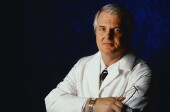
TUESDAY, Dec. 4 (HealthDay News) — Fewer medical students are choosing careers in primary care, and instead are opting to become specialists, a new study found.
The study, which appears in the medical-education-themed Dec. 5 issue of the Journal of the American Medical Association, fuels concerns that there will be a shortage of primary-care doctors available when patients need them most.
Researchers surveyed internal medicine residents about their career plans. Of nearly 17,000 third-year residents, only 21.5 percent were planning on a career as an internal medicine doctor. This included about 40 percent of students in a primary-care residency program and about 20 percent of those in a categorical residency program. These are two different tracks available within an internal medicine residency program.
Women were more likely to choose internal medicine than men, and U.S. medical school graduates were slightly more likely to opt for a career in internal medicine than international graduates, the study showed.
“This is worrisome,” said study author Dr. Colin West, an internist at the Mayo Clinic in Rochester, Minn. “In the next decade, we will be 50,000 primary-care physicians short for the needs of the country.”
Compounding the likely shortage is health care reform under the Affordable Care Act, which is expected to flood the system with new patients in the coming years.
“We will need even more primary-care physicians as the foundation of care and we are not generating enough,” West said. And, in addition to fewer residents choosing internal medicine and more patients having access to health care, many providers are getting older and heading to retirement.
“The difficulty that many people have already experienced with access to their regular physician will get significantly worse,” West said. “Access to primary care is threatened by these numbers if we don’t do something about it.”
Many ways exist to help sweeten the pot for primary-care residents, he said. For starters, medical students need to be enticed to choose primary-care careers. This may involve getting rid of some of the non-care-related demands of the job, such as paperwork and the routine time spent haggling with insurers about reimbursement, he added.
Dr. Cynthia Smith, senior medical associate for content development at the American College of Physicians, agreed that the career choice of primary care must be made more appealing.
“We haven’t done enough yet to encourage more folks to go into primary care,” Smith said. “The elephant in the room is reimbursement. Today’s primary-care physicians spend 60 percent of their time doing activities that are not currently reimbursed.” This includes following up with patients and other specialists and performing clerical duties.
As far as doctors’ training goes, “we have to enhance their educational experience outside of the hospital to give them that type of experience,” Smith said.
Study author West noted that some primary-care residents may choose specialty careers because they think they’re more lucrative. Hot career choices are cardiology, gastroenterology and radiology.
Dr. Martha Grayson, senior associate dean of medical education and a professor of clinical medicine at Albert Einstein College of Medicine in New York City, said debt forgiveness may help boost interest in primary care as many medical students have significant debt.
Another issue is lifestyle. Many medical students are choosing careers with set boundaries on their time, such as the hospitalist track. These are doctors who care for you while you are hospitalized.
“We can think about reduction of expected work hours,” Grayson said. “We need to send a clearer message on the value of primary care to medical students. In my day, almost everybody stayed in primary care after completing a primary-care internal medicine residency.”
But times have changed.
“We need to be concerned because the Affordable Care Act will allow more and more people access to health insurance and health care and that is wonderful thing, but it will exacerbate our overall shortages,” she said.
More information
What is a primary-care doctor? Find out at the U.S. National Library of Medicine.

